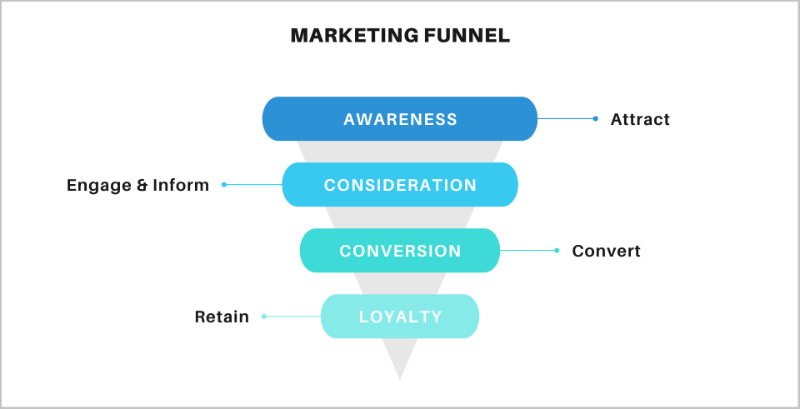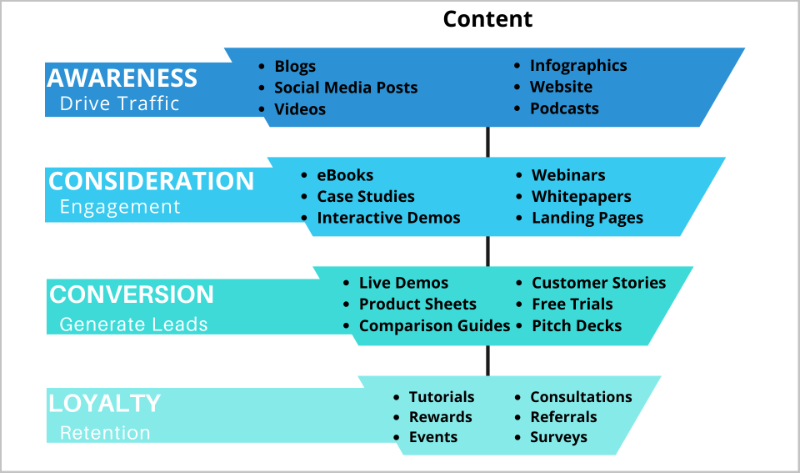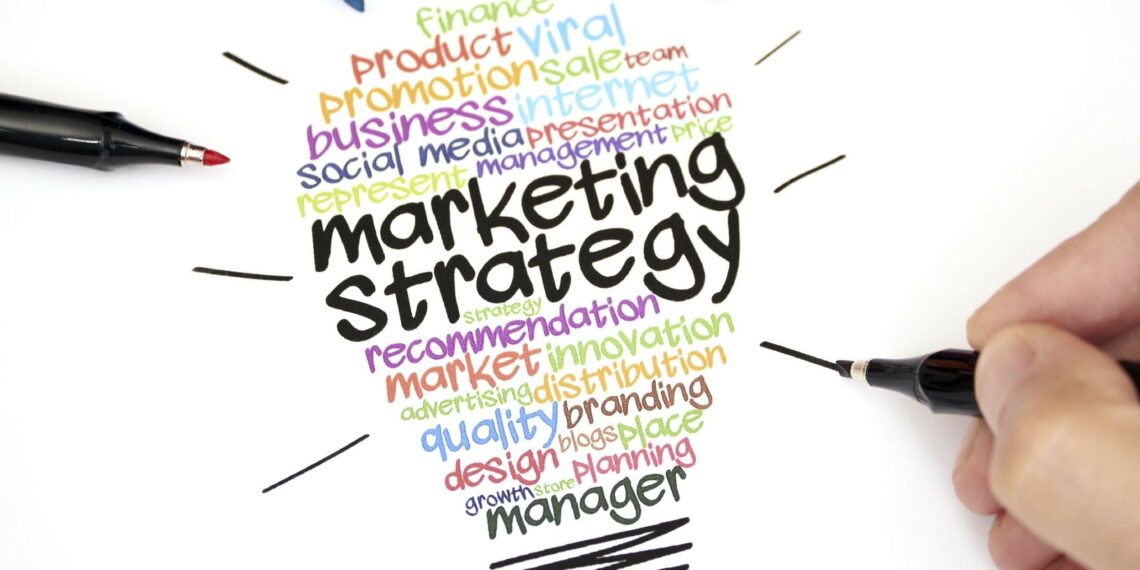A successful digital marketing content strategy requires a well-thought-out plan. You must determine what type of content works best for different stages of the customer journey.
This includes determining where visitors are coming from, what keywords they’re searching for, and what actions they want to take once they find your site through your blog posts. Once you’ve identified those things, you’ll be able to craft content that will help convert prospective customers from the awareness stage into actual customers.
The process of creating content for your marketing funnel typically involves three steps:
Research, planning, and creation.
Researching helps you understand your potential customers and discover what types of content work best for them.
Planning allows you to figure out what types of valuable content you want to produce and how you want to distribute it.
Creation is about actually producing the content itself.
You’ll need to start with some basic information like your target audience, goals, and budget.
Next, you’ll want to do keyword research to see what terms potential customers are typing into search engines.
From there, you’ll use analytics tools like Google Analytics to track your conversion rate and measure success.
Finally, you’ll decide whether to continue working on the same topics or branch off into something else.
Understanding the Marketing Funnel and Buyer’s Journey
Marketing funnels are a simple tool to understand how buyers move through the purchase journey. They show the different touchpoints along the path consumers take to make a decision. This helps identify opportunities to reach prospective buyers earlier in the funnel and target relevant messages to your target audience.
The marketing funnel consists of four stages: Awareness, Consideration, Conversion, and Loyalty. Each stage represents a distinct set of actions your potential customers perform to advance toward making a final decision. At each stage, they’ll engage with your brand differently.

Awareness – Your prospect begins their journey by becoming aware of your brand. You want to capture their attention early on.
Consideration – After learning about your brand, your prospects start thinking about whether they need your product or service.
Conversion – Once they’ve considered your offer, your prospects convert into actual buyers. This is the most important moment. You want to keep them engaged throughout the entire process.
Loyalty – Your prospects become loyal customers once they’ve purchased your product or service. Make sure you nurture them over time.
Content for Each Stage of the Funnel

Awareness
Awareness is key in the marketing funnel. The awareness stage includes content that attracts consumers. This might be blogs, videos, infographics, or other types of content that show how to solve a problem or get an answer.
In this stage, you want to focus on providing value to your prospects. Value can come in many forms such as educational articles, case studies, white papers or customer reviews. It could also include free trials, demos, or giveaways.
In his book, “Marketing Metrics,” Chris Ducker says that the most effective way to attract customers is to tell them about problems they don’t know they have. He explains, “You want to make it easy for someone to find out what you do, and why you’re different. If you’re able to solve a problem, you’ll be perceived as the best solution.”
Consideration
We often talk about how great it is to build relationships with our audience, but what we don’t always think about is that those relationships must evolve over time. When you start building a relationship with someone, there is a very clear starting point and ending point.
You begin with a question and end with a response. But once you’ve built up trust with someone, you’re no longer asking questions; you’re sharing information. You’re educating, informing, and entertaining. And you’re doing it without selling anything.
This is called consideration marketing because it’s all about getting someone to consider buying from you. Once they’ve considered you, they’ll make a purchase decision.
But what happens after that? If you want to keep growing that relationship, you need to continue providing value. So while it’s okay to ask questions, you shouldn’t stop there. You need to provide solutions.
If you’re working on a sales process, you need to understand that the goal isn’t to close deals. Instead, the goal is to convert leads into buyers. In fact, according to HubSpot, less than 30% of B2C companies actually close a deal. Why? Because the majority of salespeople focus too much on closing deals, rather than converting leads into buyers.
So let me give you some real-world examples of conversion vs. consideration. For example, take the case study. A case study is a piece of content that educates readers about your industry and provides them with useful information. They usually include statistics and facts, along with testimonials from satisfied clients.
A case study is typically written in the third person, which means that it doesn’t tell stories about the author. Instead, it tells stories about others.
In the context of a lead generation campaign, case studies are one of the best ways to convert leads into buyers because they educate prospects about your offerings, but they don’t pressure them to buy immediately. As long as you’re providing value, you’re keeping the conversation going.
Conversion
Marketing Strategy – How To Turn Prospects Into Customers
Marketing experts agree that once you’ve identified someone as a prospect, you must move them down the sales funnel. This process involves building trust, educating them about your products and services, and convincing them to buy. You’ll want to do everything possible to make sure they convert into buyers.
The key to successful content funnel conversion rate strategies is to understand what motivates prospects and how best to communicate with them. Conversion tactics are often based on the customer journey map, which helps marketers identify where people fall along the buying cycle.
Here are some tips on how to turn prospects into customers:
1. Know Your Audience
Who are they? What do they care about? Why did they come to your site? Knowing your audience gives you insight into your buyer persona’s needs, wants, and motivations. It helps you tailor your content types and messaging to resonate with them better.
2. Understand Their Journey
What does your ideal customer look like? Where do they start looking for information online? Which channels do they use most frequently? These insights give you clues about where to focus your educational content efforts.
3. Create Compelling Content
People aren’t interested in reading or listening to generic content. Instead, they want to read or hear something that resonates with them personally. Use data to determine what types of content creation work best for your target market.
4. Make Sure Your Call-to-Action Is Clear
Your call-to-action (CTA) should be clear and concise. Don’t bury it in text or clutter up your page with other elements. People will click away if they can’t find what they’re looking for.
Loyalty
Marketing expert Mark Roberge says there are three stages to nurturing a loyal customer base:
1. Attracting the customer
2. Engaging the customer
3. Retaining the customer
Once you attract a customer, you must engage them. If you do so well, you’ll retain them. And once you’ve retained them, you’re ready to upsell them. But remember, every step along the way needs to be done correctly. “If you don’t nurture loyalty, you lose it,” Roberge warns. Consumers are loyal to brands that provide consistent quality experiences over time. But how do you make sure that happens? Here are some tips to help keep your customers happy and loyal.
#1 – Be Consistent
Consistency is the foundation of loyalty. If your brand isn’t providing consistent messaging across every touchpoint, including social media posts, emails, and web pages, your audience might start losing interest.
#2 – Make Quality Your #1 Priority
Quality is the most important thing you can offer your customers. Do everything you can to ensure that your products and services meet their expectations.
#3 – Keep Them Engaged
If your customers aren’t engaged with your brand, they won’t feel compelled to spread the word about your product or service or leave customer reviews. To keep them interested, give them something extra — like exclusive deals, free trials, or discounts on future purchases.
In conclusion, creating content that converts is easier than ever these days thanks to evolving Ai, Google Analytics and other SEO tools to optimize your content funnel. There are plenty of resources available online that teach you exactly how to create content that attracts visitors, engages them, and turns them into customers.
However, if you want to really stand out from the crowd, you’ll need to focus on providing valuable information that helps your audience solve their problems. The key is to offer solutions rather than advice type pieces of content.




